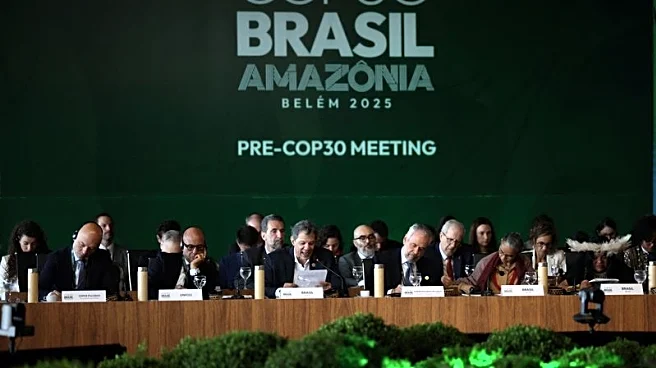What's Happening?
Fortescue's Green Pioneer, an ammonia-fueled vessel, has arrived in Belém, Brazil, to participate in COP30, emphasizing the importance of industry-regulator collaboration for zero-emission shipping. The
75-meter vessel has traveled across three continents, including stops in London, Rotterdam, Monaco, Boston, and New York, marking significant milestones such as being the first to sail on ammonia in international waters. This achievement was facilitated by successful bunkering operations in the UK, Rotterdam, and Boston, in partnership with local authorities. The Green Pioneer has been recognized as one of TIME's Best Inventions of 2025. Despite Fortescue's disappointment over the delay in adopting the International Maritime Organization's Net-Zero Framework, the company remains committed to demonstrating the feasibility of zero-emission fuels.
Why It's Important?
The arrival of Fortescue's Green Pioneer at COP30 underscores the growing momentum towards decarbonizing the shipping industry, which currently contributes 3% of global emissions, a figure projected to rise to 10% by 2040. The use of ammonia as a fuel represents a significant step in reducing the carbon footprint of maritime transport. This development is crucial for the shipping industry, which faces increasing pressure to adopt sustainable practices. The demonstration of ammonia-fueled shipping could accelerate the adoption of similar technologies, influencing regulatory frameworks and encouraging investment in green shipping solutions. Stakeholders in the shipping industry, including regulators, port authorities, and shipping companies, stand to benefit from advancements in zero-emission technologies.
What's Next?
As Fortescue continues to showcase the Green Pioneer at COP30, the focus will likely shift towards encouraging broader adoption of zero-emission fuels within the shipping industry. The delay in the International Maritime Organization's Net-Zero Framework adoption suggests ongoing negotiations and potential policy adjustments. Industry stakeholders may need to advocate for regulatory support and incentives to facilitate the transition to sustainable shipping practices. The success of the Green Pioneer could inspire further research and development in alternative fuels, potentially leading to new partnerships and collaborations aimed at achieving global shipping decarbonization goals.
Beyond the Headlines
The Green Pioneer's journey highlights the potential for ammonia as a viable alternative fuel, which could have broader implications for other industries seeking to reduce carbon emissions. The vessel's recognition as one of TIME's Best Inventions of 2025 may inspire innovation across sectors, encouraging the exploration of unconventional solutions to environmental challenges. The collaboration between Fortescue and local authorities during the vessel's bunkering operations exemplifies the importance of public-private partnerships in advancing sustainable technologies. This case could serve as a model for other industries aiming to achieve net-zero emissions.















